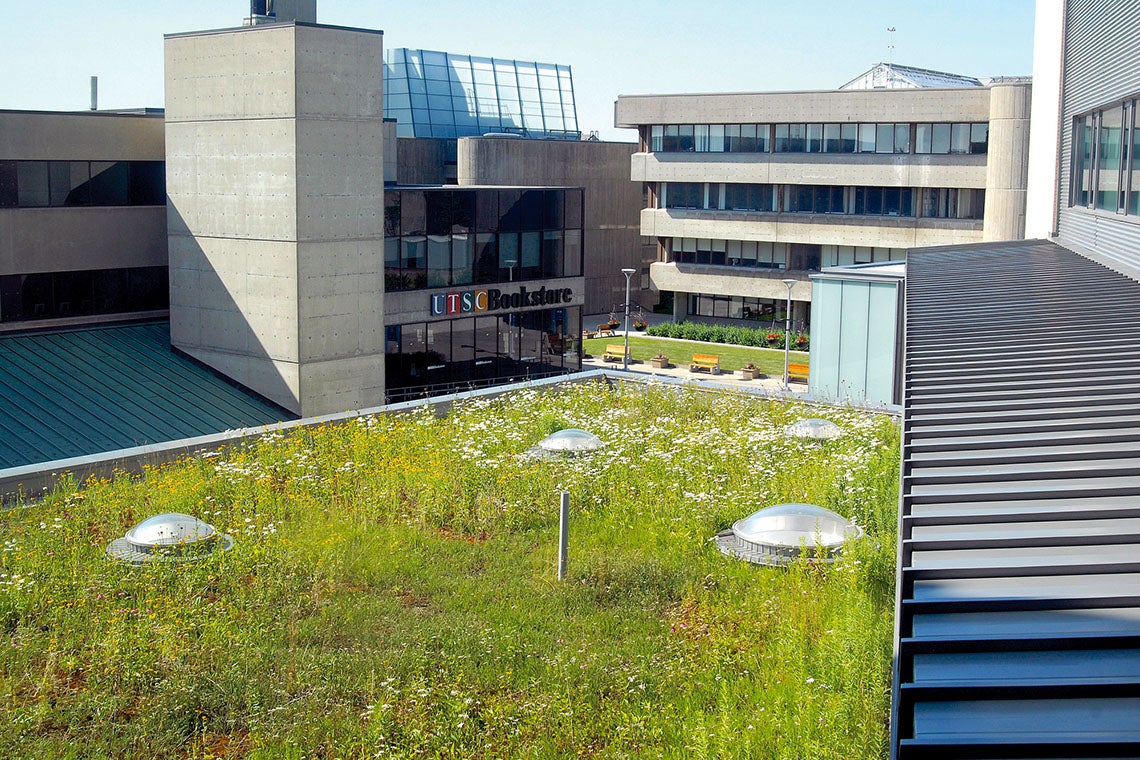
The University of Toronto has been named one of Canada's Greenest Employers in 2020 - the seventh time it has been recognized.
The designation, issued by editors of the Canada's Top 100 Employers project at Mediacorp Canada Inc., recognizes employers who are leaders in developing exceptional sustainability initiatives that reduce an organization's environmental footprint and create a culture of environmental awareness that empowers employees to contribute unique skills and is attractive to prospective clients.
For the 2020 competition, Mediacorp highlighted U of T's leadership in its early adoption of a plastic water bottle ban, as well as its numerous complimentary waste diversion initiatives and engagement programs that encourage reduction and reuse. These include the responsible recycling and collection of a range of materials, from organics to discarded laboratory glass and plastics.
In addition, U of T was recognized for its new and renovated buildings (with many in the planning stages) that showcase the latest in green building and design, including geoexchange heating and cooling systems, green and reflective white roofs, rooftop gardens, solar power generation, LED lighting systems, solar hot water heating and rainwater collection systems.
Over the past year, U of T began implementing a Low-Carbon Action Plan to put the university on a path to reduce its tri-campus greenhouse gas (GHG) emissions by 37 per cent below 1990 levels by 2030. The St. George campus, which is responsible for more than 80 per cent of U of T's carbon footprint, has also initiated a Site Utility Master Plan that will put the campus on track to achieving carbon neutrality by 2050.
"There will be no one solution and we are looking at everything" said Ron Saporta, U of T's chief operating officer, property services and sustainability. "U of T will have to draw on many new and existing approaches, as well as the expertise and commitment of the U of T community. The master plan will significantly invest in green infrastructure and promote sustainability, job creation and regional outcomes, while providing leadership and learning opportunities for staff and students alike."
Having secured provincial funding for green infrastructure in 2018, U of T implemented the first wave of projects across the three campuses. In Operations and Real Estate Partnerships, teams completed 12 projects connected to U of T's central steam plant, which heats much of the downtown Toronto campus through an underground network of tunnels and pipes.
U of T Scarborough undertook a series of electricity-related demand reduction projects, including LED retrofits that improved teaching, learning and work environments.
This year also saw construction begin on the Landmark Project, a revitalization initiative focused on Front Campus, Back Campus, King's College Circle, Hart House Circle and Sir Daniel Wilson Quad. The project will make the historic core of the St. George campus more pedestrian-friendly, create new green spaces, improve accessibility and install a massive geoexchange field below Front Campus that is expected to save 15,000 tonnes of greenhouse gas emissions a year. The field will help heat and cool surrounding buildings in winter and summer, which will have been retrofitted from traditional gas-fired systems to take advantage of the geoexchange distributed system, which applies oil and gas sector technology to store energy in the ground.
"Not only is this the largest such project in Canada, but we're doing this in the historic core of campus, in and around historic buildings," Saporta said. "If we can show that this works here, it speaks to what can be done to aged infrastructure and old buildings in the entire province of Ontario, now and with future generations."
U of T Mississauga, meanwhile, has become the first campus in Canada to receive a silver designation from Fair Trade Canada, which supports small-scale farm organizations that meet specific social, economic and environmental standards. Working with certified suppliers helps ensure better prices and working conditions for farmers and workers in the program.
"UTM has a commitment to sustainability, so it makes sense to incorporate that goal into food services on campus," says Sarah Holden, project manager for the fair trade initiative and marketing and communications strategist with U of T Mississauga's Hospitality & Retail Operations team. "This commitment to fair trade provides the UTM community with dining options that support the rights of producers and standards for environmental protection."
Being a green employer is also about making the most of employees' specialized sustainability-related skills. Such was the case with Doug Graham, a property manager at the university who graduated from the Ontario Institute for Studies in Education with a focus on sustainability and community development. In a previous role with the Faculty of Kinesiology & Physical Education (KPE), Graham gained experience working in pool maintenance. Given his blend of education and experience, he was asked to oversee the installation of solar panels to heat water for swimming pools.
"It was important to me to be associated with such an important project," Graham said. "Energy consumption and usage at the university is a big deal as we strive to meet U of T's climate commitment goals. Any time we can offset those costs by bringing in a more sustainable plan is really satisfying, especially since I had managed these buildings in the past. The use of photovoltaic and photo thermal technology at the Faculty of Kinesiology & Physical Education will help in the provision of programs and community building for years to come.
"The solar project is something I'm very proud to have been a part of."






